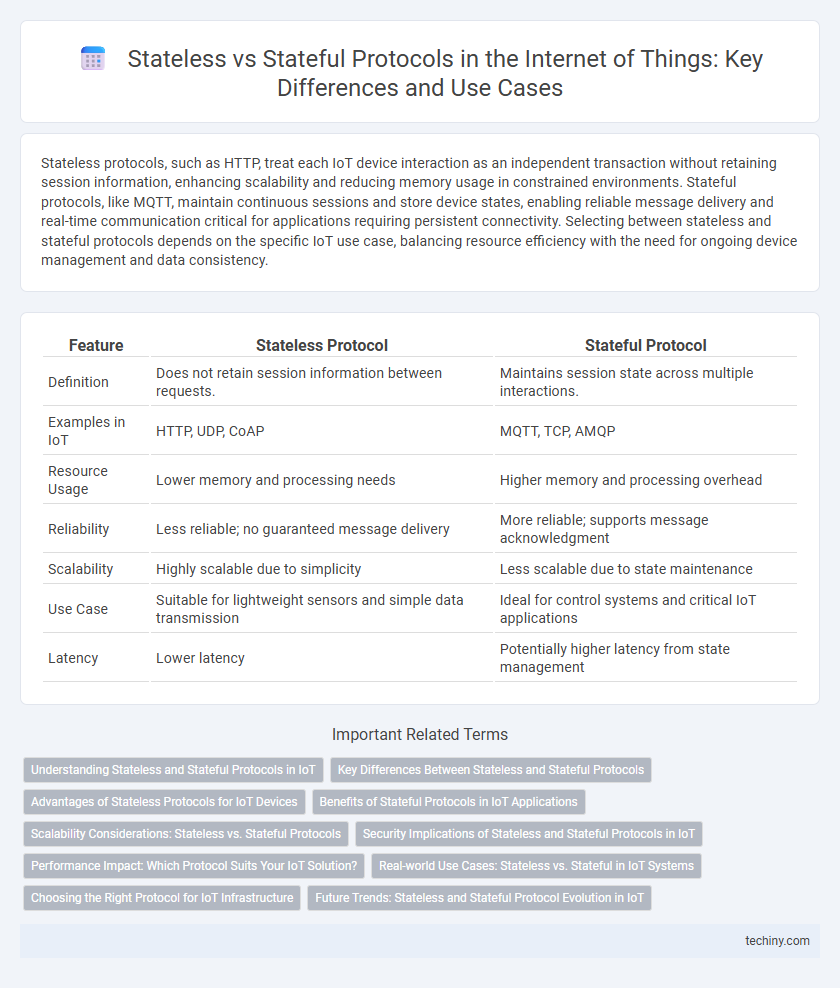Stateless protocols, such as HTTP, treat each IoT device interaction as an independent transaction without retaining session information, enhancing scalability and reducing memory usage in constrained environments. Stateful protocols, like MQTT, maintain continuous sessions and store device states, enabling reliable message delivery and real-time communication critical for applications requiring persistent connectivity. Selecting between stateless and stateful protocols depends on the specific IoT use case, balancing resource efficiency with the need for ongoing device management and data consistency.
Table of Comparison
| Feature | Stateless Protocol | Stateful Protocol |
|---|---|---|
| Definition | Does not retain session information between requests. | Maintains session state across multiple interactions. |
| Examples in IoT | HTTP, UDP, CoAP | MQTT, TCP, AMQP |
| Resource Usage | Lower memory and processing needs | Higher memory and processing overhead |
| Reliability | Less reliable; no guaranteed message delivery | More reliable; supports message acknowledgment |
| Scalability | Highly scalable due to simplicity | Less scalable due to state maintenance |
| Use Case | Suitable for lightweight sensors and simple data transmission | Ideal for control systems and critical IoT applications |
| Latency | Lower latency | Potentially higher latency from state management |
Understanding Stateless and Stateful Protocols in IoT
Stateless protocols in IoT, such as UDP, do not retain session information, enabling faster communication with reduced latency but requiring devices to handle error correction independently. Stateful protocols like TCP maintain connection states, ensuring reliable data transmission and ordered delivery crucial for applications demanding data integrity. Understanding the trade-offs between stateless and stateful protocols helps optimize IoT network performance, balancing speed and reliability based on use case requirements.
Key Differences Between Stateless and Stateful Protocols
Stateless protocols in the Internet of Things (IoT) environment do not retain any session information between requests, allowing devices to communicate with minimal overhead and improved scalability. Stateful protocols maintain context and session data across multiple interactions, enabling reliable data exchange and complex device coordination but requiring more memory and processing power. Key differences include stateless protocols offering simplicity and faster response times, while stateful protocols provide enhanced communication reliability and support for continuous device states.
Advantages of Stateless Protocols for IoT Devices
Stateless protocols in IoT devices offer advantages such as reduced memory usage and simplified server design, enabling efficient handling of millions of sensor nodes with limited computational resources. These protocols improve scalability and fault tolerance by eliminating the need to maintain session information, which minimizes latency and enhances real-time data transmission. Common stateless protocols like MQTT and CoAP optimize network performance and battery life, crucial for IoT deployments with constrained devices.
Benefits of Stateful Protocols in IoT Applications
Stateful protocols in IoT applications enhance data reliability by maintaining connection context and session information, ensuring consistent communication between devices. These protocols enable efficient resource management and error recovery, crucial for real-time monitoring and control in smart environments. Increased security measures are also supported through continuous state tracking, reducing the risk of unauthorized access and data breaches.
Scalability Considerations: Stateless vs. Stateful Protocols
Stateless protocols enhance scalability in Internet of Things (IoT) environments by reducing server memory usage and simplifying load balancing across numerous devices. Stateful protocols maintain session information, allowing richer interactions but increasing resource demands and limiting scalability in large-scale IoT deployments. Choosing between stateless and stateful protocols depends on balancing resource constraints with communication complexity in IoT systems.
Security Implications of Stateless and Stateful Protocols in IoT
Stateless protocols in IoT minimize server-side resource consumption by not retaining session information, reducing exposure to certain attack vectors such as session hijacking. Stateful protocols maintain session context, enabling more robust authentication and authorization processes that enhance security but increase vulnerability to resource exhaustion and denial-of-service attacks. Balancing these approaches requires implementing lightweight encryption and stringent access controls to mitigate risks while optimizing performance in resource-constrained IoT environments.
Performance Impact: Which Protocol Suits Your IoT Solution?
Stateless protocols, such as UDP, enhance IoT performance by minimizing memory usage and reducing latency, making them ideal for resource-constrained devices requiring fast, lightweight communication. Stateful protocols like TCP ensure reliable data delivery through connection management and error correction, but this increases bandwidth and processing overhead, potentially impacting IoT devices with limited power and processing capability. Choosing between stateless and stateful protocols depends on the specific IoT application's requirements for reliability, latency, and resource availability.
Real-world Use Cases: Stateless vs. Stateful in IoT Systems
Stateless protocols like CoAP excel in IoT systems requiring low overhead and simplicity, such as sensor networks and environmental monitoring, where devices intermittently send data without maintaining session information. Stateful protocols, exemplified by MQTT, suit applications needing continuous connection and reliable message delivery, including smart home automation and industrial control systems. Choosing between stateless and stateful protocols depends on factors like network stability, data transmission frequency, and resource constraints of IoT devices.
Choosing the Right Protocol for IoT Infrastructure
Stateless protocols like UDP offer low overhead and faster communication ideal for IoT devices with limited resources, while stateful protocols such as TCP provide reliable data transmission and error recovery essential for critical IoT applications. Selecting the right protocol depends on the specific IoT infrastructure requirements, including device capability, network reliability, and data integrity needs. Balancing these factors ensures optimized performance, energy efficiency, and scalability in IoT deployments.
Future Trends: Stateless and Stateful Protocol Evolution in IoT
Future trends in IoT emphasize the evolution of stateless protocols to enhance scalability and reduce latency by minimizing server-side storage requirements, critical for massive device deployments. Stateful protocols continue to advance with adaptive session management and improved security frameworks to support complex IoT applications requiring persistent connections and real-time data synchronization. Hybrid models integrating stateless efficiency with stateful reliability are emerging, optimizing resource use while maintaining robust communication for diverse IoT ecosystems.
Stateless protocol vs Stateful protocol Infographic

 techiny.com
techiny.com